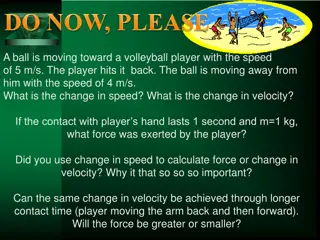Momentum and Collisions Explained Through Illustrations
Explore various scenarios involving momentum, collisions, and elastic interactions through illustrated examples. Understand concepts such as total momentum in different situations, speeds of masses after collisions, momentum conservation in 1-D and 2-D collisions, and changes in momentum direction. Test your knowledge through interactive scenarios involving balls, masses on a frictionless surface, and accelerating cars on Earth.
Download Presentation

Please find below an Image/Link to download the presentation.
The content on the website is provided AS IS for your information and personal use only. It may not be sold, licensed, or shared on other websites without obtaining consent from the author.If you encounter any issues during the download, it is possible that the publisher has removed the file from their server.
You are allowed to download the files provided on this website for personal or commercial use, subject to the condition that they are used lawfully. All files are the property of their respective owners.
The content on the website is provided AS IS for your information and personal use only. It may not be sold, licensed, or shared on other websites without obtaining consent from the author.
E N D
Presentation Transcript
In which situation is the magnitude of the total momentum of the system the largest? I: v m 2m (rest) II: v v m 2m A) Situation I has larger total ? B) Situation II has larger total ? C) Same total ? in both situations
Two masses, ? and 3?, are at rest on a frictionless surface. A compressed, massless spring between them is suddenly allowed to uncompress, pushing the masses apart. After the masses are apart, the speed of ? is ____ the speed of 3?. A) the same as B) two times C) three times D) nine times E) None of these
A car sits on the Earths surface. Both the car and the Earth are at rest. (Pretend the Earth is not rotating or revolving around the Sun.) The car accelerates to a final velocity. After the car reaches vfinal, the magnitude of the Earth's momentum is __________ the magnitude of the car's momentum. A) more than B) the same as C) less than D) It depends on the ratio of the mass of the car and the mass of the Earth
I: v m 2m (rest) Two masses are about to collide and stick together, what will be the final speed? II: v v m 2m A) zero B) ? C) ?/2 D) ?/3 E) none of these
Ball 1 strikes stationary Ball 2 in a one dimensional (1-D) collision. Two of the relevant momenta, ?1,? and ?2,? are given in the figure. Taking the positive direction to the right, what is ?1,?in graph units ? A) 0 B) +2 C) 2 D) Something else E) Wait, this is impossible!
Ball 1 strikes stationary Ball 2 in a 2-D collision. Two of the relevant momenta, ?1,? and ?2,? are given in the figure. Taking the positive direction to the right, what is ?1,?,?in graph units ? A) 0 B) +1 C) -1 D) None of these E) This time it s impossible!
A ball bounces off the floor elastically as shown. The direction of change in momentum of the ball, ?, is A) Straight up B) Straight down C) To the right D) To the left E) Zero
Suppose a tennis ball and a bowling ball are rolling toward you. Both have the same momentum, and you exert the same force to stop each. How do the time intervals to stop them compare? A) It takes less time to stop the tennis ball. B) Both take the same time. C) It takes more time to stop the tennis ball.
Ball 1 of mass m moving right with speed ? bounces off ball 2 with mass ? (? > ?), and then moves left with speed 2?. What is the magnitude of the impulse delivered to ball 1? M M m m v 2v A) ?? Before After B) 2?? C) 3?? 1 2?? D) E) None of these
Ball 1 of mass m moving right with speed ? bounces off ball 2 with mass ? (? > ?), and then moves left with speed 2?. By how much did the momentum of ball 2 decrease? M M m m v 2v A) M? Before After B) 2?? C) 3?? 1 2?? D) E) None of these
Which ball is more likely to knock over the wood? A) The elastic, bouncy one (the happy ball) B) The inelastic, flat one (the sad ball) C) Both equally likely
Two masses, ? and 3?, are at rest on a frictionless surface. A compressed, massless spring between them is suddenly allowed to uncompress, pushing the masses apart. After the masses are apart, the KE of ? is ____ the KE of 3?. A) the same as B) greater than C) less than
Two masses ?1 and ?2 are approaching each other on a frictionless table and collide. Is it possible that, as a result of the collision, all of the kinetic energy of both masses is converted to other forms of energy? [You aren t given the masses or speeds I m asking whether there exist masses and speeds such that it s possible] A) Yes, all the KE can disappear B) No, it s impossible
A moving mass ?1 is approaching a stationary mass ?2 on a frictionless table. Is it possible that, as a result of the collision, all of the kinetic energy of both masses is converted to other forms of energy? [Again, I m asking whether there exist masses and speeds such that it s possible] A) Yes, all the KE can disappear B) No, it s impossible
A big ball, mass ? = 10?, speed ?, strikes a small ball, mass ?, at rest. Could the following occur? The big ball comes to a complete stop and the small ball takes off with speed 10?. (Assume they all remain at constant temperature.) A) Yes, it could. B) No, it would violate conservation of momentum. C) No, it would violate conservation of energy.
A bullet (mass ?, velocity ?) is fired into a wood block (mass ?) initially at rest on a frictionless surface. The bullet buries itself in the wood block and then the wood block is seen to have a final velocity ??. Was this an elastic collision? A) Yes B) No
A bullet (mass ?, velocity ?) is fired into a wood block (mass ?) initially at rest on a frictionless surface. The bullet buries itself in the wood block and then the wood block is seen to have a final velocity ??. True or False: ?? = ??? A) True B) False
A bullet (mass ?, velocity ?) is fired into a wood block (mass ?) initially at rest on a frictionless surface. The bullet buries itself in the wood block and then the wood block is seen to have a final velocity ??. True or False: 1 2??2=1 2(? + ?)??2 A) True B) False
A bullet of mass m traveling horizontally with initial speed v strikes a wooden block of mass M resting on a frictionless table. The bullet buries itself in the block, and the block+bullet have a final speed vf. Fill in the blank: The total kinetic energy of the bullet+block after the collision is _________ the total KE before the collision. M+m v m M vf Before After A) greater than B) less than C) equal to
A Cadillac and a Volkswagen have a head-on collision and stick to together in a mangled pile of metal. The police determine that the wreckage is in the exact same spot where the two cars collided. Detective O'Newton (who got an A in Physics 1110) writes in her report that, just prior to the collision, the two cars had the same... A) magnitude of momentum B) kinetic energy C) mass D) speed
Roughly where do you expect the CM of a semicircular arc of solid material? D) None of these looks even close!
Four square floor tiles are laid out in an L-pattern as shown. The origin of the x-y axes is at the center of the lower left tile. Find the x-coordinate of the center of mass. A) a B) a/2 C) a/3 D) a/4 E) None of these
Four square floor tiles are laid out in an L-pattern as shown. The origin of the x-y axes is at the center of the lower left tile. Find the y-coordinate of the center of mass. A) a B) a/2 C) a/3 D) a/4 E) None of these
A mass ? moves right with speed ?. It is heading to collide with mass 2? (which is at rest). What is the velocity ??? of the system BEFORE the collision? A) v B) v/2 C) v/3 D) 2/3 v E) 0
A mass ? moves right with speed ?. It is heading to collide with mass 2? (which is at rest). What is the velocity ??? of the system AFTER the collision? A) still v/3 B) 0 C) something else D) It depends on if its and elastic collision or not
Suppose you are on a cart, initially at rest on a track with very little friction. You throw balls at a partition that is rigidly mounted on the cart. If the balls bounce straight back as shown in the figure, is the cart put in motion? A) Yes, to the left B) Yes, to the right C) No
You see a cart, initially at rest on a track with very little friction. There is a thin curtain in front of it. Then you see some heavy balls start flying out to the right. As they start coming out, is the cart put in motion? A) Yes, to the left B) Yes, to the right C) No
In the previous question(s), what is happening to the location of the CM of the entire system (person + cart + heavy balls) A) Shifting left B) Shifting right C) Staying put























